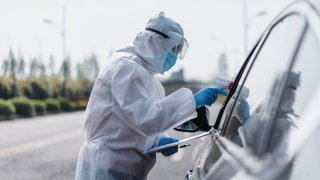
A research team led by a professor of mechanical and aerospace engineering in the UCLA Samueli School of Engineering won a grant to develop an inexpensive and fast breathalyzer-like diagnostic tool to test for the novel coronavirus that causes COVID-19, according to the university.
"Unfortunately, the COVID-19 pandemic has exposed a critical weakness in health care security infrastructure, which is a substantial deficiency in our capabilities to conduct rapid, simple, point-of-care diagnostic and environmental sample collection and testing,'' said Pirouz Kavehpour, whose team has received a one-year, $150,000 research grant from the National Science Foundation.
"The goal in this research is to develop cheap, massively deployable, rapid diagnostic and sentinel systems for detecting respiratory illness and airborne viral threats," Kavehpour said.
He said the design could also be altered to detect other infectious diseases and airborne viral threats by continuously monitoring the air of indoor environments, such as hospitals, schools and airports.
The concept is based on an environmental water condensation technology developed by Kavehpour and his research group, which includes four additional UCLA investigators, two from Northeastern University and one from the University of Massachusetts, Amherst.
They have applied for a patent for the design, according to UCLA.
Although similar in use to breathalyzer tests which use infrared light to measure blood-alcohol levels, the method behind the COVID-19 diagnostic test is different, according to a university statement.
Local
Get Los Angeles's latest local news on crime, entertainment, weather, schools, COVID, cost of living and more. Here's your go-to source for today's LA news.
For the coronavirus test, a person would exhale into the device for about a minute. Water vapor from their breath would condense on a special plate. Live virus and virus RNA could then be screened by using fluorescent genetic tags that light up if the virus is present. It could take about 10 minutes to show results.
If the design is successful and meets all federal criteria, test kits could be in production as early as this fall, according to Kavehpour, who is also a professor of bioengineering.



